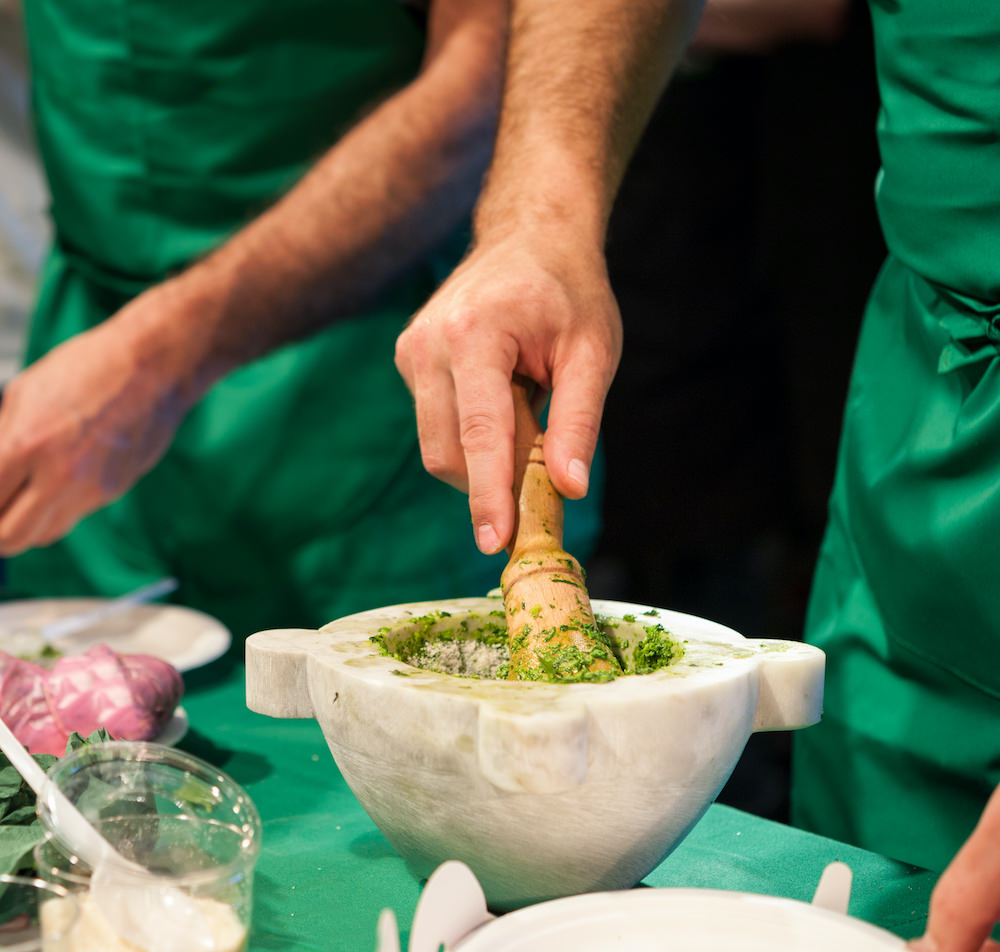Pesto is one of the most appreciated and best known Italian products worldwide. But the real Italian pesto, the authentic one from its original region of Liguria, is not as widespread. A recipe full of history, passion, art and tradition that has been handed down since the XII century. The real Ligurian pesto has a unique green color and a surprising creaminess with a flavor that can only be achieved by pounding the basil from Liguria in a mortar. Here is everything you need to know about real Ligurian pesto, its ancient recipe and preparation.
The history of the true Ligurian pesto
The first written recipe is found on Emanuele Rossi’s True Genoese Cuciniera (1852): Pesto d’Aglio e Basilico. Until then the recipe for Genoese pesto had been handed down by word of mouth since the 12th century. At that time the Republic of Genoa included Corsica and Sardinia. Despite being a maritime republic, what has always characterized Ligurian cuisine is not fish, but aromatic herbs. In fact, in the Middle Ages the control of the spice trade from the east was under the dominion of another maritime republic, Venice, historic enemy of Genoa. So the Genoese became skilled in growing, mixing and cooking aromatic herbs. An ancient tradition that gave rise to pesto.
Why is Ligurain pesto so unique
The basil with the most intense flavor in the world
What makes the real Ligurian pesto so unique is the Genoese basil, which includes 3 of the 69 worldwide varieties that grow spontaneously in Asia, Africa and Central America. For centuries this plant has spread almost everywhere, especially in the Mediterranean Basin. In Liguria, climatic conditions give basil a unique flavor and color that is not present in plants grown even just a few kilometers further south. In fact, the leaves take on a minty flavor that becomes stronger as you move south. Only true Ligurian pesto offers maximum quality, intense aroma, a lively color and an unmistakable taste.
Sardinian pecorino
Another fundamental difference that characterizes authentic Ligurian pesto is the addition of Sardinian pecorino, a seasoned sheep’s cheese often overlooked in the revisited recipes. Aged Sardinian pecorino has a very strong flavor, which is why it is added in smaller quantities than Parmesan.
The authentic recipe of the garlic and basil pesto
The ancient Ligurian recipe of 1852 demands only the use of local ingredients:
- Basil from the area of the city of Prà, the most prized, or from the Ponente areas.
- Garlic of Vessalico (city in the province of Imperia).
- Pine nuts from Pisa.
- Parmigiano Reggiano DOP, aged 24 months.
- Pecorino Sardo DOP, aged 15 months.
- Coarse sea salt.
- Ligurian Riviera DOP extra virgin olive oil (sweet and ripe).
Anyone, however, can make a good authentic pesto using fresh and genuine ingredients. Basil leaves must be young, sweet and fresh. The smaller leaves must be selected, because they yield better quality. The pine nuts must be lightly toasted in a pan before being crushed. Garlic must be strictly fresh and each segment cut in half. To be sure that it is the real Parmigiano Reggiano one must use the one with the PDO indication (Protected Designation of Origin)
Pecorino sardo must also be marked as PDO. You can also use the pecorino Romano (also PDO) which is easier to find, but the unmistakable flavor of the Sardinian pecorino is the best choice. The olive oil must be high quality, Italian extra virgin DOP. Sea salt is preferably coarse.
Quantity for 6 people
- 8 bunches of basil
- 3 cloves of fresh garlic
- 35 g. of pine nuts
- 50 g. of PDO Parmigiano Reggiano
- 10 g. of Pecorino Sardo PDO
- 2 g. of coarse sea salt
- 7-8 cl. of extra virgin olive oil
HOW PESTO IS PREPARED

The word pesto derives from the verb pestare (hammering or crushing).
In a mortar, start by crushing the garlic and sea salt. Only when they have become a soft paste, add the pine nuts and continue pounding. It is at this point that the basil comes into play. Now, unlike the previous ingredients, basil must be gently pressed against the sides of the mortar, not at the base. When everything is well mixed and creamy it is time to add the grated cheese and then the oil, being careful not to pour too much: the pesto sauce must be mixed evenly, not an oily solution!
How to use Pesto
In Italy pesto is almost never cooked, but simply mixed in the plate at the last minute, to maintain its liveliness.
Tradition has it that it is served with gnocchi, trofie or linguine. However, it goes well with any pasta format, as long as it is authentic Italian quality pasta made with traditional processing. In fact, it is the best type of pasta to capture the pesto and bring out its qualities.
A good fresh white wine is the perfect pairing.
In addition to pasta, in Italy, pesto can be added to vegetable minestrone soup or a simple tomato soup. Also excellent for stuffing chicken breast and tomatoes, both fresh and baked, adding pesto at the last minute.


 FiorFiore USA
FiorFiore USA